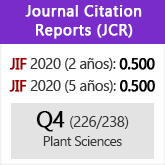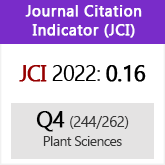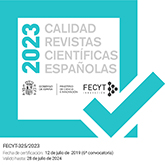Respuestas fotosintéticas y zonación de tres especies de Gelidiales de Tenerife, Islas Canarias
DOI:
https://doi.org/10.3989/ajbm.2280Palabras clave:
ecofisiología, fotosíntesis, Gelidiales, Gelidium, Islas Canarias, PterocladiellaResumen
Se han seleccionado tres especies de Gelidiales (Gelidium arbuscula, Gelidium canariense y Pterocladiella capillacea) que son abundantes en los niveles inferiores del intermareal de la costa N de Tenerife para establecer, utilizando fluorescencia tipo PAM, la importancia de la cantidad de luz y la exposición al aire en su zonación vertical. Se ha comparado la tolerancia a la emersión en frondes expuestas al aire, y los resultados sugieren que la capacidad de recuperación de la fotosíntesis tras la emersión tiene un papel fundamental en la explicación de la posición vertical de estas tres especies. Además, características morfológicas como el apelotonamiento de las frondes pueden coadyuvar a la mayor tolerancia, al reducir la pérdida de agua en emersión en las especies de niveles más altos. Las variaciones entre sitios se pueden deber a desigualdades locales en la cantidad de luz provocadas por diferencias topográficas.
Descargas
Citas
Beer, S. & L. Axelsson. 2004. Limitations in the use of PAM fluorometry for measuring photosynthetic rates of macroalgae at high irradiances. European Journal of Phycology 39: 1-7. http://dx.doi.org/10.1080/0967026032000157138
Bischof, K., Gómez, I., Molis, M., Hanelt, D., Karsten, U., Lüder, U., Roleda, M.Y., Zacher, K. & Wiencke, C. 2006. Ultraviolet radiation shapes seaweed communities. Reviews in Environmental Science and Biotechnology 5: 141-166. http://dx.doi.org/10.1007/s11157-006-0002-3
Chapman, A.R.O. 1973. A critique of prevailing altittudes towards the control of seaweed zonation on the seashore. Botanica Marina 16: 80-82. http://dx.doi.org/10.1515/botm.1973.16.2.80
Chapman, A.R.O. 1974. The ecology of macroscopic marine algae. Annual Review of Ecology and Systematics 5: 65-80. http://dx.doi.org/10.1146/annurev.es.05.110174.000433
Dring, M.J. & Brown, F.A. 1982. Photosynthesis of intertidal brown algae during and after periods of emersion: a renewed search for physiological causes of zonation. Marine Ecology Progress Series 8: 301-308. http://dx.doi.org/10.3354/meps008301
Flores-Moya, A., Gómez, I., Viñegla, B., Altamirano, M., Pérez-Rodríguez, E., Maestre, C., Caballero, R. & Figueroa, F.L. 1998. Effects of solar radiation on the endemic Mediterranean red alga Rissoella verruculosa: photosynthetic performance, pigment content and the activities of enzymes related to nutrient uptake. New Phytologist 139: 673-683. http://dx.doi.org/10.1046/j.1469-8137.1998.00233.x
Franklin, L.A. & Badger, M.R. 2001. A comparison of photosynthetic electron transport rates in macroalgae measured by pulse amplitude modulated chlorophyll fluorometry and mass spectrometry. Journal of Phycology 37: 756-767. http://dx.doi.org/10.1046/j.1529-8817.2001.00156.x
Genty, B., Briantais, J.M. & Baker, N.R. 1989. The relationship between the quantum yield of photosynthetic electron transport and quenching of chlorophyll. Biochimica et Biophysica Acta 990: 87-92.
Gevaert, F., Creach, A., Davoult, D., Holl, A.-C., Seuront, L. & Lemoine, Y. 2002. Photo-inhibition and seasonal photosynthetic performance of the seaweed Laminaria saccharina during a simulated tidal cycle: chlorophyll fluorescence measurements and pigment analysis. Plant, Cell and Environment 25: 859-872. http://dx.doi.org/10.1046/j.1365-3040.2002.00869.x
Gil-Rodríguez, M.C. & Wildpret, W. 1980. Contribución al estudio de la vegetación ficológica marina del litoral canario. Aula de Cultura Excmo. Cabildo Insular de Tenerife.
Gómez, I. & Figueroa, F.L. 1998. Effects of UV stress on chlorophyll fluorescence kinetics of intertidal macroalgae from southern Spain: a case study in Gelidium species. Journal of Applied Phycology 10: 285-294. http://dx.doi.org/10.1023/A:1008021230738
Hall, D.O. & Rao, K.K. 1999. Photosynthesis. Cambridge University Press, Cambridge.
Hanelt, D., Huppertz, K. & Nultsch, W. 1993. Daily courses of photosynthesis and photo-inhibition in marine macroalgae investigated in the laboratory and field. Marine Ecology Progress Series 97: 31-37. http://dx.doi.org/10.3354/meps097031
Hunt, L.J.H. & Denny, M.W. 2008. Desiccation protection and disruption: a trade-off for an intertidal marine alga. Journal of Phycology 44: 1164-1170. http://dx.doi.org/10.1111/j.1529-8817.2008.00578.x
Huppertz, K., Hanelt, D. & Nultsch, W. 1990. Photo-inhibition of photosynthesis in the marine brown alga Fucus gardneri as studied in field experiments. Marine Ecology Progress Series 66: 175-182. http://dx.doi.org/10.3354/meps066175
Lewis, J.R. 1964. The Ecology of Rocky Shores. English University Press, London.
Mercado, J.M., Niell, F.X. &. Gil-Rodríguez, M.C. 2001. Photosynthesis might be limited by light, not inorganic carbon availability, in three intertidal Gelidiales species. New Phytologist 149: 431-439. http://dx.doi.org/10.1046/j.1469-8137.2001.00050.x
Montalva, S. & Santelices, B. 1981. Interspecific interference among species of Gelidium from Central Chile. Journal of Experimental Marine Biology and Ecology 53: 77-88. http://dx.doi.org/10.1016/0022-0981(81)90085-X
Oates, B.R. & Murray, S.N. 1983: Photosynthesis, dark respiration and dessication resistance of the intertidal seaweeds Hesperophycus harveyanus and Pelvetia fastigiata f. gracilis. Journal of Phycology 19: 371-380. http://dx.doi.org/10.1111/j.0022-3646.1983.00371.x
Pérès, J.M. 1982. Zonations and organismic assemblages. In: Kinne, O. (ed.), Marine Ecology, Vol. V, Ocean management, Part 1. Wiley, Chichester, pp. 9-576.
Pinedo, S. & J. Afonso-Carrillo. 1994. Distribución y zonación de las algas marinas bentónicas en Puerto de la Cruz, Tenerife. Vieraea 23: 109-123.
Rico, J.M. 1991. Field studies and growth experiments on Gelidium latifolium from Asturias (N Spain). Hydrobiologia 221: 67-75. http://dx.doi.org/10.1007/BF00028363
Rico, J.M. & Fredriksen, S. 1996. Effects of environmental factors on net photosynthesis and growth of intertidal species of the genus Gelidium (Gelidiaceae, Rhodophyta) in northern Spain. Scientia Marina 60: 265-273.
Santelices, B. 1991. Production ecology of Gelidium. Hydrobiologia 221/222: 31-44. http://dx.doi.org/10.1007/BF00028360
Silva, J., Santos, R., Serodio, J. & Melo, R.A. 1998. Light response curves for Gelidium sesquipedale from different depths, determined by two methods: O2 evolution and chlorophyll fluorescence. Journal of Applied Phycology 10: 295-301. http://dx.doi.org/10.1023/A:1008057008447
Stephenson, T.A. & Stephenson. A. 1972. Life Between Tide- Marks on Rocky Shores. W.H. Freeman, USA.
Wiencke, C., Gómez, I., Pakker, H., Flores-Moya, A., Altamirano, M. Hanelt, D., Bischof, K. & Figueroa, F.L. 2000. Impact of UV-radiation on viability, photosynthetic characteristics and DNA of brown algal zoospores: implications for depth zonation. Marine Ecology Progress Series 197: 217-229. http://dx.doi.org/10.3354/meps197217
Williams, S.L. & Dethier, M.N. 2005. High and dry: variation in net photosynthesis of the intertidal seaweed Fucus gardneri. Ecology 86: 2373-2379. http://dx.doi.org/10.1890/04-1569
Descargas
Publicado
Cómo citar
Número
Sección
Licencia
Derechos de autor 2011 Consejo Superior de Investigaciones Científicas (CSIC)

Esta obra está bajo una licencia internacional Creative Commons Atribución 4.0.
© CSIC. Los originales publicados en las ediciones impresa y electrónica de esta Revista son propiedad del Consejo Superior de Investigaciones Científicas, siendo necesario citar la procedencia en cualquier reproducción parcial o total.Salvo indicación contraria, todos los contenidos de la edición electrónica se distribuyen bajo una licencia de uso y distribución “Creative Commons Reconocimiento 4.0 Internacional ” (CC BY 4.0). Puede consultar desde aquí la versión informativa y el texto legal de la licencia. Esta circunstancia ha de hacerse constar expresamente de esta forma cuando sea necesario.
No se autoriza el depósito en repositorios, páginas web personales o similares de cualquier otra versión distinta a la publicada por el editor.

















